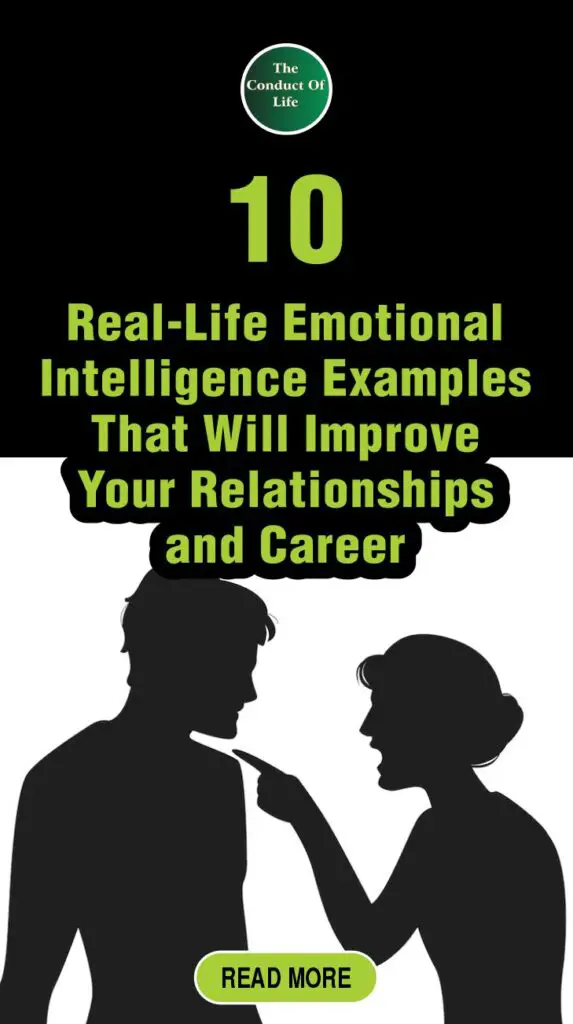Last updated on November 18th, 2025 at 07:39 am
It’s easy to talk about emotional intelligence every day, but quite hard to practice in real life. Here are 10 real-life emotional intelligence examples to improve your relationships and career.
Think about the last time you stayed calm during an argument or helped a teammate feel heard.
That’s emotional intelligence in action. It’s how you understand your feelings, respond to others, and build stronger connections without saying much.
You don’t need a psychology degree to use it. You just need to notice how emotions show up in everyday situations.
This post will show you 10 clear emotional intelligence examples you’ll recognize from work, relationships, and daily conversations.
As you read, ask yourself: Do I do this? Could I try this next time?
Each example is simple, relatable, and something you can start using right away to improve how you lead, listen, and relate to others.

Real-Life Emotional Intelligence Examples in Action: 10 Examples Worth Learning From
1. Staying Calm During Negative Feedback
(Shows Self-regulation)
Staying calm when negative feedback is one of the emotional intelligence examples a few people have.
I remember a popular incident where a Facebook user gave an honest negative review of a tomato puree, and the company came after her with lawsuits, accusing her of disreputing the product.
The company received backlash from the public, and there was a boycott of the product.
An emotionally intelligent company would have seized that opportunity to market their product, but chose the mud.
Imagine you’re in a team meeting, and your manager criticizes a project you worked hard on.
Your first reaction might be to get defensive or shut down.
But instead, you take a deep breath, listen carefully, and ask clarifying questions without letting your emotions take over.
This is self-regulation in action, a core part of emotional intelligence.
Rather than reacting impulsively, you pause, manage your response, and stay focused on the feedback.
A former colleague once received harsh feedback on a presentation.
Instead of lashing out, he calmly took notes, thanked the reviewer, and used the input to improve his next pitch.
His professionalism earned him more respect than the presentation itself. That’s the power of staying calm under pressure.
2. Recognizing When You’re Triggered Instead of Reacting
(Shows Self-awareness)
Another emotional intelligence example is recognizing when you are triggered and intentionally handling your emotions.
Having a grip on your emotions is one of the greatest skills you can get for daily living.
You’ve been there: someone says something that hits a nerve, and your first instinct is to snap back or even throw a punch.
But instead, you pause. That pause is self-awareness in action.
Emotional intelligence means knowing when you’re triggered and choosing not to react without thinking.
You notice the tension in your chest, the rush of heat, the urge to defend.
Rather than saying something you’ll regret, you ask yourself: Why does this bother me so much?
That moment of reflection helps you respond with clarity instead of emotion.
It’s not about being passive. It’s about staying in control of your choices.
When you recognize your triggers, you build stronger relationships and avoid regret.
That’s what sets emotionally intelligent people apart in everyday life.
Related Posts
What Is Low Emotional Intelligence?
Best-Rated Emotional Intelligence Courses for Workers
Beginners’ Guide to Understanding Emotions
The Difference Between Empathy, Sympathy, Compassion and Pity
Tips for Emotional Management In The Workplace
10 Powerful Emotions Used in Persuasion
3. Giving Someone Space Without Taking It Personally
(Shows Empathy)
The third emotional intelligence example in real life is showing empathy.
Sometimes you have this genuine intention to reach out to people, but they seem indifferent and not looking inviting.
You reach out, and they pull back. It’s easy to feel rejected.
But instead of making it about you, you take a step back and think: maybe they just need time.
This is empathy at work. Emotional intelligence shows when you respect someone’s space without assuming the worst.
You remind yourself: not every silence means disinterest. People process things differently.
Maybe they’re overwhelmed, maybe they need quiet, or maybe they’re figuring out how to respond.
By giving them room without reacting with blame or insecurity, you show maturity.
You listen without pushing. You care without clinging. And in doing so, you give your relationships the space they need to breathe and grow.
That’s emotional awareness in real time.
4. Choosing Words That Heal in a Conflict
(Shows Social skills)
When you choose your words intentionally by observing situations, environment, and studying the moods, you are showing emotional intelligence in real life.
You’re in the middle of a heated conversation. Tension rises, and you feel tempted to say something sharp.
But you pause and choose your words with care. That’s emotional intelligence in action.
Instead of pointing fingers, you say: I feel hurt instead of you hurt me. You speak to be understood, not to win.
Choosing words that calm rather than cut shows strong social skills. It helps the other person lower their guard.
You stay present, listen fully, and respond with intention. This doesn’t mean avoiding hard truths.
It means saying them in a way that invites connection, not distance. In conflict, your words can either burn bridges or build them.
Emotionally intelligent people choose to build.
5. Admitting You Were Wrong and Apologizing
(Shows Self-awareness & Humility)
Also, when you admit that you are wrong instead of letting ego be your driver, you are exhibiting emotional intelligence.
You messed up. Maybe you said the wrong thing or made a decision that hurt someone.
Instead of defending it or shifting blame, you say: I was wrong. I’m sorry. That simple moment shows emotional intelligence at its core.
It takes real self-awareness to admit a mistake and humility to own it without excuses.
You don’t wait for them to point it out. You take responsibility because you value the relationship more than your pride.
Apologizing doesn’t make you weak; it shows strength. It rebuilds trust, clears tension, and opens the door for healing.
People remember how you made them feel, and owning your wrongs makes them feel respected.
That’s the power of emotional growth in everyday life.
6. Encouraging Others Without Making It About You
(Shows Empathy & Motivation)
Someone shares their goal or struggle, and instead of shifting the spotlight to your own story, you stay focused on them.
You say: I believe in you. You’ve got this. That’s emotional intelligence, knowing when to support without taking over.
It’s not the time to say what you did or how you succeeded. It’s their moment, and you respect that.
You listen, you cheer them on, and you offer help only if they ask. This shows both empathy and the ability to inspire.
Your words become a steady hand on their back, not a microphone in your hand.
When you lift others without needing credit, you become someone they trust, someone who helps them keep going.
7. Checking In on a Quiet Colleague
(Shows Empathy and Social Awareness)
You notice a shift: the colleague who’s usually chatty has gone quiet. Instead of brushing it off, you check in.
You ask: Hey, is everything okay? That small question shows emotional intelligence.
It means you’re paying attention, not just to tasks, but to people. You’re aware of the energy around you and how others are feeling.
You don’t push or pry. You give them space to talk, or not talk, without judgment.
Sometimes, just knowing someone noticed makes a difference. Empathy isn’t loud.
It’s found in the quiet moments, the thoughtful glances, the simple gestures that say: you’re not alone.
Emotionally intelligent people tune in and reach out, and that’s what makes workplaces feel human.
8. Reframing Criticism to Avoid Conflict
(Shows Self-regulation and Communication Skills)
Someone criticizes your work, and your first instinct is to defend yourself.
But instead of reacting, you take a breath and ask: What can I learn from this?
That shift in mindset shows emotional intelligence. You reframe the criticism, not as a personal attack, but as feedback.
You choose words that invite clarity instead of tension. You say: Thanks for the input.
Can you help me understand what you’d like to see?
That response shows control over your emotions and skill in how you communicate.
It keeps the conversation productive, not combative. When you regulate your response and focus on solutions, you set the tone for respect.
Emotionally intelligent people turn friction into progress, one calm reply at a time.
9. Walking Away to Avoid Saying Something You’ll Regret
(Shows Impulse Control)
Your anger rises. Words rush to your mouth, ready to spill out. But instead of speaking, you walk away.
That pause is emotional intelligence in motion. It’s not weakness, it’s control.
You know that saying something in the heat of the moment could damage trust or hurt someone you care about.
So you give yourself space to cool down and think. You might say: I need a moment, I don’t want to say the wrong thing.
That small decision shows strength. It means you’re not ruled by emotion, even when it’s loud.
Emotionally intelligent people don’t suppress feelings; they manage them.
Walking away isn’t avoiding the issue.
It’s protecting the relationship until you’re ready to speak with clarity, not anger.
10. Supporting a Friend Without Fixing Their Problems
(Shows Emotional Support Without Overstepping)
Your friend is struggling. You want to help, but instead of rushing in with solutions, you sit with them.
You say: I’m here if you need me. That’s emotional intelligence. It takes restraint to offer comfort without taking control.
You listen, nod, and let them feel heard. You don’t need to solve it. You just need to stay present.
By not overstepping, you give them space to process, decide, and heal on their terms.
Sometimes, the most powerful support isn’t advice, it’s quiet company.
Emotionally intelligent people know when to speak and when to simply be there.
You show respect for their strength, their process, and their pace. That’s how real support looks and feels.
What These Emotional Intelligence Examples Teach Us
These examples remind you that emotional intelligence isn’t something you just know; it’s something you practice every single day.
It shows up in small choices: how you listen, how you speak, how you pause before reacting.
Developing emotional intelligence takes effort, but it’s worth it. You learn it by doing, not by reading definitions, but by reflecting on real moments like these. Journaling can help.
After reading each example, take a moment to ask yourself: Do I handle this well?
What could I do differently next time? The more you reflect, the stronger your emotional muscles grow.
Keep practicing. Emotional intelligence is learned, lived, and improved. Bookmark or pin this post as a reminder of how emotional intelligence shows up every day.
References
Pious Clements is the insightful voice behind "The Conducts of Life" blog, where he writes about life ethics, self-development, life mastery, and the dynamics of people and society.
With a profound understanding of human behaviuor and societal dynamics, Pious offers thought-provoking perspectives on ethical living and personal growth.
Through engaging narratives and astute observations, he inspires readers to navigate life's complexities with wisdom and integrity, encouraging a deeper understanding of the human experience and our place within society.
